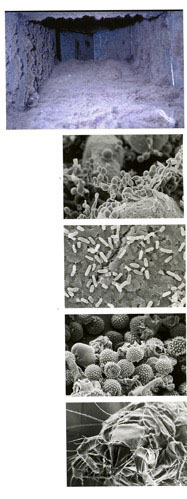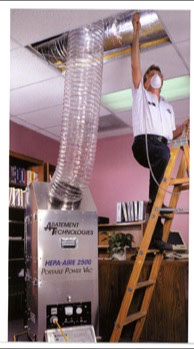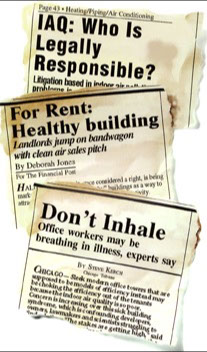
Call Us 603-598-0625
Sick Building Syndrome is real...
and so are the consequences.


Indoor air quality for business...
...more than a compliance issue...
it makes good business sense to improve productivity while conserving energy.
Ensuring clean, healthy indoor air is a necessity for a productive business. According to NEMI (National Energy Management Institute): "Benefits of improved IAQ (indoor air quality) are so large that this opportunity cannot be ignored... these include improved productivity, increased profits, greater employee/ customer/visitor health, and reduced health costs."
Conversely, the failure of a building owner or an employer to provide clean indoor air can result in costly consequences including health problems, absenteeism, reduced productivity, higher premiums for worker's comp and health insurance, and lost tenants. Moreover, U.S. courts have consistently ruled that building owners have a non-deferrable legal obligation to provide building occupants with a safe and healthful environment.
Indoor air quality is the environmental issue of the '90's. The USEPA has ranked poor IAQ as one of the highest risks to human health among all types of environmental problems. In fact, according to studies conducted by EPA, NIOSH and others, the average measured levels of many hazardous pollutants may be as much as 100 times higher in indoor air than in the air outside. The World Health Organization has estimated that 30% of all buildings experience IAQ problems. These problems are especially prevalent in tight, energy-efficient buildings where a high percentage of recirculated air is utilized.
According to the highly respected Journal of American Medical Association: "the risk of respiratory infection is 45% higher among occupants of energy efficient buildings."
Common indoor air contaminants include fibers and chemicals from carpeting and fabrics; formaldehyde and other chemicals from furniture; vapors from cleaning and copier chemicals; and hair, dander and germs from the occupants themselves. The combined health effects of these pollutants on building occupants can be significant, especially on those suffering from allergies, asthma or other respiratory ailments.
What you can't see can hurt you.
A building's air duct network acts as its respiratory system. Dirt, dust, debris and microbial growth that accumulate inside of air ducts hidden from view "congest" the system and make it difficult for the building to "breathe" properly and function efficiently. In fact, a 1987 ASHRAE study concluded that maintaining system cleanliness would reduce average operating costs by 10 to 25%.
More than 70% of all IAQ problems involve the HVAC system. Dirty air ducts are an ideal breeding ground for mold spores, mildew, bacteria (including Legionella) and other health-threatening microbial growth. Dirty ducts can also result in higher utility bills, reduced air supply and premature failure of expensive HVAC components.
(Enlarged samples taken from HVAC duct debris -from top to bottom) Fungi, bacteria, pollen and dust mites. These pollutants can circulate freely through the air ducts of a poorly or improperly maintained HVAC system. 42,000 dust mites can be found in one ounce of dust.
The Solution: Clean air ducts for cleaner air.
Sick Building Syndrome and its very real costs can be prevented. Our high quality commercial duct cleaning service enables our clients to provide ultra-clean indoor air, and to realize the common sense business advantages that accrue from a well-maintained air duct system.
Using state-of-the-art equipment and source removal techniques, our crews are able to access and thoroughly clean the entire duct system.
99.97% of the removed contaminants down to 0.3 microns in size are captured by the HEPA-AIRE® portable power vac's high efficiency filtration system. Air exhausted back into the facility is clean enough to meet surgical standards.
HEPA-AIRE® is a registered trademark of Abatement Technologies, Inc., Lawrenceville, GA.
No wonder everyone's turning their focus indoors!
Worker Productivity
NEMI reports significant worker productivity gains after implementing IAQ improvements.
Health Risks
Over 21,000,000 Americans suffer needlessly from the toxic effects of poor indoor air quality.
Absenteeism
The cost of a sick building is high absenteeism and reduced productivity.
Lost Tenants
Polluted indoor air pushes tenants away, allowing them to successfully break leases.
Lawsuits/Comp Claims
Huge judgments and Worker's Compensation claims paid to injured employees are only the beginning.
Government Regulations
Proposed regulations from OSHA include fines, penalties and additional compliance requirements.
High Utilility Expenses
Dirty, restricted HVAC systems can double utility costs in addition to causing air flow losses of up to 500%.
Early Equipment Failure
A dirty HVAC system can lead to premature failure of mechanical components.
High Management Costs
Crisis management is an expensive way to handle IAQ.
The proactive solution to indoor air quality problems in facilities includes the use of advanced HEPA-AIRE® duct cleaning equipment by Abatement Technology.

Serving Southern New Hampshire and Eastern Massachusetts for over 50 years!